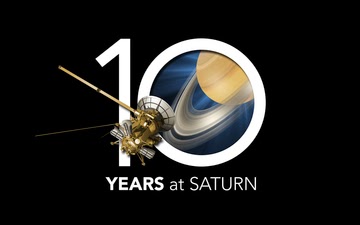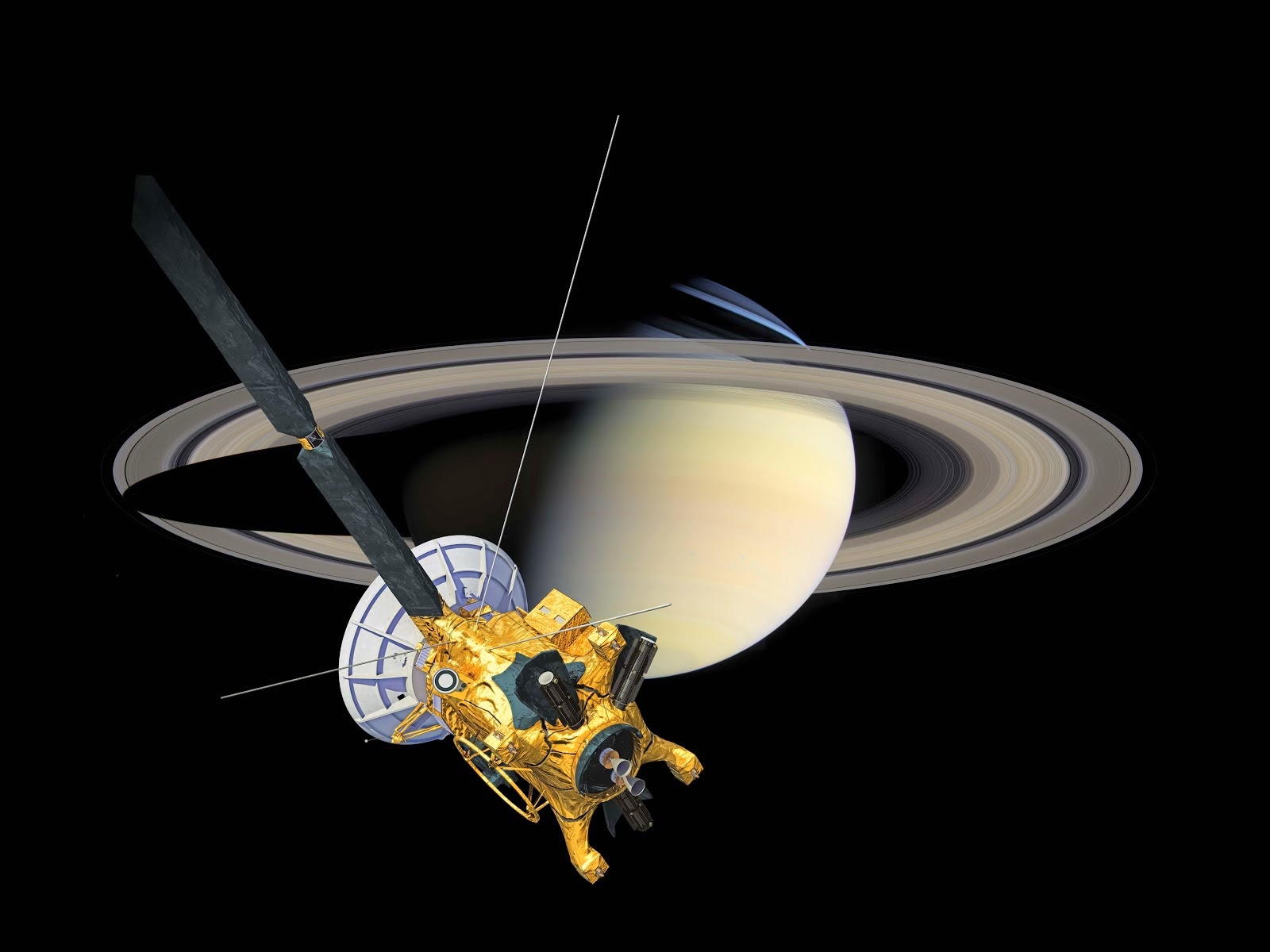Cassini 10 Years at Saturn logo.
June 25, 2014
Cassini Saturn Arrival
Video above: A look back at Cassini's arrival at Saturn. Video Credit: NASA/JPL-Caltech.
It has been a decade since a robotic traveler from Earth first soared over rings of ice and fired its engine to fall forever into the embrace of Saturn. On June 30, the Cassini mission will celebrate 10 years of exploring the planet, its rings and moons.
The Cassini spacecraft, carrying the European Space Agency's Huygens probe, arrived in the Saturn system on June 30, 2004, for a four-year primary mission. Since 2008, NASA has granted the mission three extensions, allowing scientists an unprecedented opportunity to observe seasonal changes as the planet and its retinue completed one-third of their nearly 30-year-long trek around the sun.
Image above: Cassini completed its four-year primary mission in 2008 and went on to perform dozens more flybys of Titan, Enceladus and Saturn's other icy moons through its 10th anniversary in 2014. The mission may continue through 2017. Image Credit: NASA/JPL-Caltech.
"Having a healthy, long-lived spacecraft at Saturn has afforded us a precious opportunity," said Linda Spilker, Cassini project scientist at NASA’s Jet Propulsion Laboratory in Pasadena, California. "By having a decade there with Cassini, we have been privileged to witness never-before-seen events that are changing our understanding of how planetary systems form and what conditions might lead to habitats for life."
After 10 years at Saturn, the stalwart spacecraft has beamed back to Earth hundreds of gigabytes of scientific data, enabling the publication of more than 3,000 scientific reports. Representing just a sampling, 10 of Cassini’s top accomplishments and discoveries are:
-- The Huygens probe makes first landing on a moon in the outer solar system (Titan)
-- Discovery of active, icy plumes on the Saturnian moon Enceladus
-- Saturn’s rings revealed as active and dynamic -- a laboratory for how planets form
-- Titan revealed as an Earth-like world with rain, rivers, lakes and seas
-- Studies of Saturn's great northern storm of 2010-2011
-- Studies reveal radio-wave patterns are not tied to Saturn’s interior rotation, as previously thought
-- Vertical structures in the rings imaged for the first time
-- Study of prebiotic chemistry on Titan
-- Mystery of the dual, bright-dark surface of the moon Iapetus solved
-- First complete view of the north polar hexagon and discovery of giant hurricanes at both of Saturn's poles
"It’s incredibly difficult to sum up 10 extraordinary years of discovery in a short list, but it’s an interesting exercise to think about what the mission will be best remembered for many years in the future," Spilker said.
Further details about each of these top-10 discoveries are available at:
http://saturn.jpl.nasa.gov/news/cassinifeatures/10thannivdiscoveries/
In celebration of the 10th anniversary, members of the Cassini team selected some of their favorite images for a gallery, describing in their own words what makes the images special to them. The gallery is available at: http://saturn.jpl.nasa.gov/news/cassinifeatures/10thannivimages/
While Cassini was originally approved for a four-year study of the Saturn system, the project's engineers and scientists had high hopes that the mission might carry on longer, and designed the system for endurance. The spacecraft has been remarkably trouble-free, and from an engineering standpoint, the main limiting factor for Cassini's lifetime now is how much propellant is left in its tanks. The mission owes a great deal of its longevity to skillful and efficient piloting by the mission's navigation and operations teams.
Cassini spacecraft around Saturn. Image Credit: NASA/JPL-Caltech
"Our team has done a fantastic job optimizing trajectories to save propellant, and we've learned to operate the spacecraft to get the most out of it that we possibly can," said Earl Maize, Cassini project manager at JPL. "We're proud to celebrate a decade of exploring Saturn, and we look forward to many discoveries still to come."
The Cassini-Huygens mission is a cooperative project of NASA, the European Space Agency and the Italian Space Agency. JPL, a division of the California Institute of Technology, Pasadena, manages the mission for NASA's Science Mission Directorate in Washington.
More information about Cassini is available at the following sites:
http://www.nasa.gov/cassini and http://saturn.jpl.nasa.gov and http://www.esa.int/Our_Activities/Space_Science/Cassini-Huygens
Images (mentioned), Video (mentioned), Text, Credits: NASA / JPL / Preston Dyches / Whitney Clavin.
Best regards, Orbiter.ch



